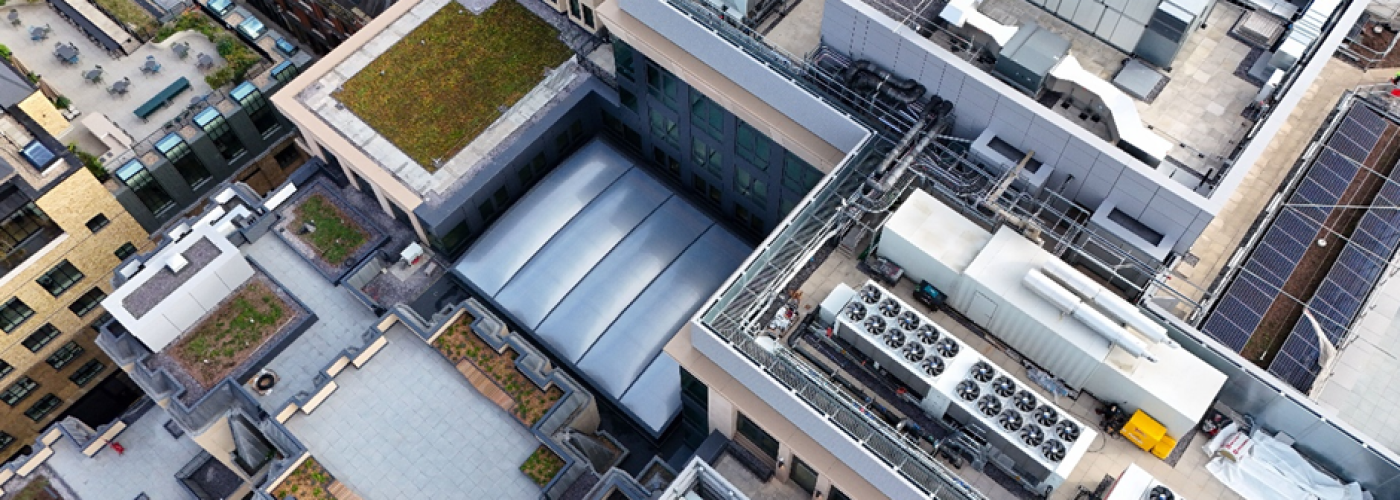When a blue roof was needed as part of a major sustainable renovation at the Acre in London, it was vital that the solution specified could be installed while other work on aspects of the roof were underway. With so many moving parts to the renovation, ACO Building Drainage had to work with contractors to be able to make their usual installation process more dynamic and accommodate unexpected changes along the way.
The brutalist building – previously known as 90 Long Acre, now shortened to The Acre – was built in the 1970s and by 2020 was in need of major renovations to restore its status as one of Covent Garden’s architectural highlights. The 240,000 square foot building would include office spaces, a café, and 113 residential flats. Moreover, once complete, The Acre was to be one of the most eco-friendly developments in the city.
Boosting The Acre’s green credentials meant overhauling several key systems including heating, the electrical supply, and roof drainage. With conditions around the site and the project itself meaning storage space was limited, deliveries had to be carefully planned and ACO’s speedy adaptability proved to be a major advantage. With ACO’s contributions to the project, The Acre went on to be awarded Sustainability Project of the Year by the LRWA.
Commencing with calculations
ACO Building Drainage was invited by building design firm Arup to collaborate on the roof drainage part of The Acre’s renovation. ACO visited the site and provided calculations for the water attenuation the building would need, and recommended products that could provide the attenuation required in line with the overall sustainability goals and planning conditions of the project.
ACO’s calculations accounted for the different sections of roof and the fact that raised areas of the roof drained onto lower parts. The provided calculations also took into consideration the combination of blue and blue green roof that was to be installed as part of the plan to better conserve water, boost biodiversity, clean the air, and improve the microclimate of The Acre.
Following the calculations however, complications arose due to the concurrent installation of solar equipment and privacy screening on the same areas of the rooftop where ACO’s RoofBloxx were to be installed.
Unexpected obstructions
Due to limited on-site storage space and multiple aspects of the renovation being carried out simultaneously, only a small portion of the required ACO RoofBloxx could be delivered at a time. To overcome this challenge, ACO communicated closely with Lendlease’s site managers and adapted its usual delivery process to ensure product was at The Acre at the time it was needed. This flexibility was made possible due to ACO’s facility in Shefford, which houses products ready for shipping in cases when short lead-times or sudden changes are a factor.
The main hurdle ACO and contractors from MAC Roofing had to contend with was the unexpected appearance of struts installed directly onto the rooftop to support other building services. These were in place to hold PV panels and screens to block plant equipment from public view to improve The Acre’s visual aesthetic.
The schematic for the ACO RoofBloxx installation had been created before these struts were known to ACO. MAC Roofing discovered their placement when they arrived to carry out the drainage installation. Because of this, designs had to be adapted quickly, while ensuring that the finished product would provide the attenuation needed and prevent any leaks.
Cutting carefully
For each of the more-than one-hundred struts MAC had to work around, pitch pockets had to be put in, the insulation had to be altered, and the ACO RoofBloxx units had to be cut to fit the space available. MAC contractors measured the obstruction, cut the ACO RoofBloxx units to the new size by hand, and then taped and sealed each part individually. ACO provided instructions on how to do this without risking any unwanted water ingress. With each cut that had to be made, the potential for leaks increased, therefore it was vital to the success of the project that the unplanned adaptations were completed to a high standard across all seven sections of roof.
Once the ACO RoofBloxx units were in place, other parts of the renovation meant that pipes and pedestals were placed directly on to the ACO RoofBloxx which was also an unforeseen change. ACO created a new set of structural load calculations to ensure that the components combined with the gravel would not compromise the ACO RoofBloxx’ performance or any aspect of building safety.
Layers and loads
In most blue roof systems, the final ballast weight needed to prevent insulation floating is significant and can impact load calculations as well as project costs and timelines as delivery and placement of ballast material is factored in. Due to ACO’s patented system which prevents the floatation of insulation on an inverted roof, only normal ballast weight is required, keeping costs low and project timelines on track.
With ACO’s expertise, even with the unexpected challenges encountered during the project, MAC Roofing and ACO were able to complete their part of the project successfully, providing The Acre with a sustainable roof drainage system. The complications highlight the need for drainage to be a consideration from the very early stages of any building or renovation project.
Rowan Gutteridge, Group Director at MAC said: “As with many construction projects, unexpected challenges arise all the time and we work to overcome them. The changes here were bigger than usual and it was in large part thanks to ACO that we were able to complete this installation successfully. When we suddenly had to cut the ACO RoofBloxx to shape, ACO’s expert advice meant we knew exactly how to do it and what adjustments were needed for the installation to make sure everything delivered the desired result. The ACO RoofBloxx units themselves are easy to work with which only helped the project progress. I’m looking forward to working with ACO and its products again on future projects.”
Kevin Bohea, Managing Director at ACO Building Drainage said: “It’s great to see an iconic building like The Acre embracing sustainable drainage. We did hit a few speedbumps along the way so we were glad to be working with MAC Roofing who we consulted with on how best to adapt the installation to the new requirements. Every project has adjustments that need to be made along the way and this one was no different. Quite a bit needed to change while the project was live, but thanks to guidance from our experts and our solutions being easy to use, the team were able to take on the challenge and ensure the installation was completed to an award-winning standard.”
For more on ACO Building Drainage and the roofing solutions they provide, see ACO.co.uk
Building, Design & Construction Magazine | The Choice of Industry Professionals





